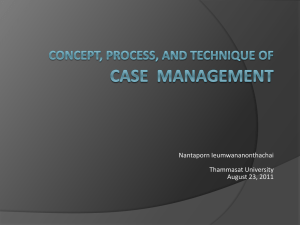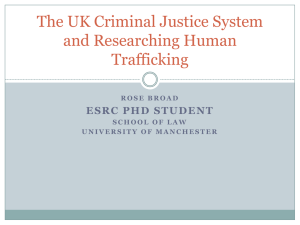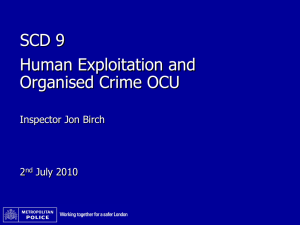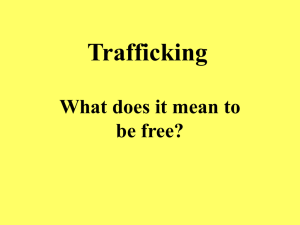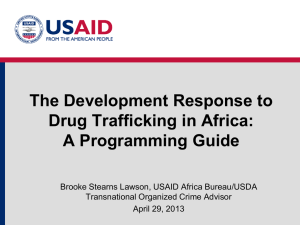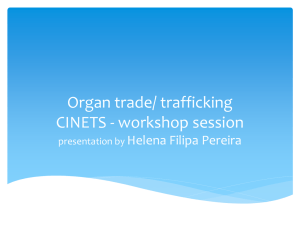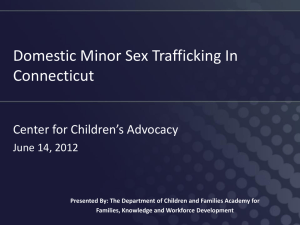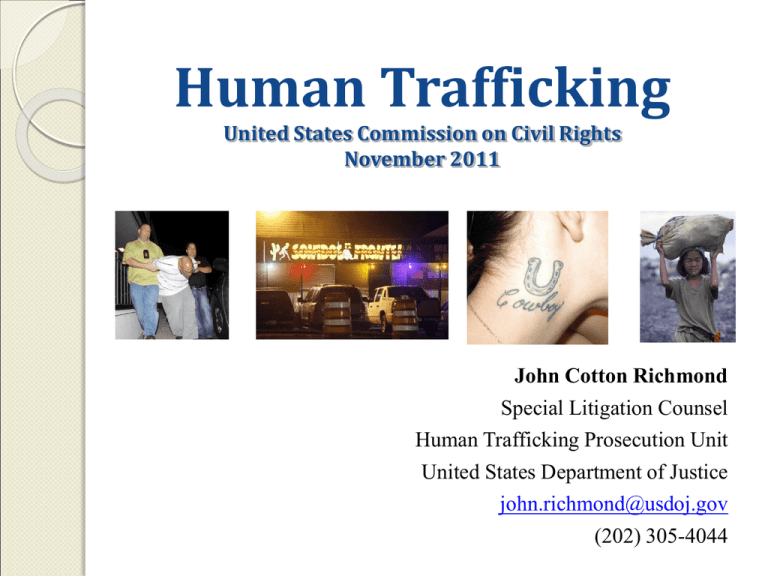
Human Trafficking
United States Commission on Civil Rights
November 2011
John Cotton Richmond
Special Litigation Counsel
Human Trafficking Prosecution Unit
United States Department of Justice
john.richmond@usdoj.gov
(202) 305-4044
Today’s Goals
• Deconstruct 6 Myths about Human Trafficking
• Understand Federal Human Trafficking Statutes
• Review the Investigation & Prosecution Model
• Define Human Trafficking Indicators
What is Human Trafficking?
Working Definition
“Human Trafficking” is compelling
someone to work or to engage in a
commercial sex act.
The Big Picture
Protect specific victims through rescue, services, and
a victim centered approach to the rule of law.
Prevent human trafficking offenses by dismantling
trafficking networks, building awareness, and creating
deterrence.
Prosecute the perpetrators for their criminal conduct
to the full extent of the law.
Victim-Centered Approach
What Does “Victim-Centered” Mean?
• Non-Prosecution of Victims
• Vindicates victim’s individual rights
• Empowers victim as an active participant
• Aids transition from traumatized victim to
empowered survivor
Transform Law Enforcement Culture
• Abandonment of pre-conceptions
• Evolution of trauma-informed approaches
Myths About
Human Trafficking
Human Trafficking Myths
1. Slavery is a historical blight that no longer exists.
• 12.3 Million victims of human trafficking
U.S. Department of State, Trafficking in Persons Report 2010
• 27 million people held in slavery worldwide
Free The Slaves 2011
• 100,000 children in U.S. are in sex trade
Polaris Project 2011
Human Trafficking Myths
2.
There are no foreigners in the case
The law does not require foreign victims or defendants.
United States v. Evans, 476 F.3d 1176 (11th Cir. 2007) (both the
Defendant and the human trafficking victim were United States citizens).
Human Trafficking Myths
3. Trafficking Involves Movement and Borders
• No Borders Needed
• No Legal Requirement
• Trafficking is Misleading
• Coercion not Movement
• Traffickers Don’t See
Borders
Human Trafficking Myths
3. Trafficking Involves Movement and Borders
Trafficking
COERCION
Undocumented
Voluntary
Crime against boarders
Transportation
Human Trafficking Myths
3. Trafficking Involves Movement and Borders
Smuggling
Trafficking
MOVEMENT
COERCION
Human Trafficking Myths
3. Trafficking Involves Movement and Borders
Smuggling
Trafficking
MOVEMENT
COERCION
Undocumented
Voluntary
Crime against boarders
Transportation
Citizen or Undocumented
Coerced / Involuntary
Crime against Person
Exploitation
Human Trafficking Myths
3. Trafficking Involves Movement and Borders
You Cannot Take a
Picture of Coercion
Human Trafficking Myths
4. This case does not involve prostitution or sex.
“Recent studies show the majority of human
trafficking in the world takes the form of forced
labor.” Dept. of State’s 2010 Trafficking in Persons Report.
•
Restaurant Workers
Farmers
Factory Workers
•
Domestic Servants
Hotel Employees
Restaurant Workers
The Law Has No Occupation Limitation
Don’t Forget About the Labor Cases
Human Trafficking Myths
5.
The “victims” have to think they are “victims.”
Often human trafficking victims do not self identify as
victims.
• Shame
• Lack understanding about their rights
• Distrust of law enforcement
• Still believing the coercive lies of the perpetrator
• Not ready to admit the truth to themselves yet
Human Trafficking Myths
6. There Will Not be Prior Inconsistent Statements
•
Embrace prior inconsistent statements.
• Most trafficking victims will not tell the complete truth
during the first few interviews.
• Evolving statements can be evidence of the coercive
scheme
What Human Trafficking Is Not!
•
•
•
•
•
•
Illegal Child Adoption
Trade in Human Organs
Child Pornography
Prostitution (Not a Federal Vice Squad)
Labor Violations
Poor Working or Living Conditions
There are other statutes that deal with theses
offenses.
Federal Laws
Involuntary Servitude and Slavery Crimes
• 18 U.S.C. § 1581 (Peonage)
• 18 U.S.C. § 1583 (Enticement Into Slavery)
• 18 U.S.C. § 1584 (Involuntary Servitude)
_____________________________________
Trafficking Victims Protection Act
•
•
•
•
18 U.S.C. § 1589 (Forced Labor)
18 U.S.C. § 1590 (Trafficking Into Servitude)
18 U.S.C. § 1591 (Sex Trafficking)
18 U.S.C. § 1592 (Document Servitude)
Forced Labor | 18 U.S.C § 1589
1
2
Provides or Obtains Labor or
Services of a Person
3
Force or
Threats
Knowingly
Through 1 of 4
Prohibited Means
Serious
Harm
Abuse of
Law
Scheme Plan
or Pattern
Forced Labor | 18 U.S.C § 1589
1
2
Provides or Obtains Labor or
Services of a Person
3
Force or
Threats
Knowingly
Through 1 of 4
Prohibited Means
Serious
Harm
Abuse of
Law
Scheme Plan
or Pattern
Forced Labor | 18 U.S.C § 1589
1
2
Provides or Obtains Labor or
Services of a Person
3
Force or
Threats
Knowingly
Through 1 of 4
Prohibited Means
Serious
Harm
Abuse of
Law
Scheme Plan
or Pattern
Forced Labor | § 1589
Element 3: Four Prohibited Means
1.
2.
3.
4.
Force, or Threats of Force or Physical Restraint
Serious Harm or Threats of Serious Harm
Abuse or threatened abuse of law or legal
process
Scheme, plan, or pattern intended to instill fear
of serious harm or physical restraint to any
person
Only Need 1 Prohibited Means.
Forced Labor | § 1589
Prohibited Means: Serious Harm:
Physical Harm
* Threats
* Beatings
* Sexual Violence
Nonphysical Harm
* Psychological Harm
* Financial Harm
* Reputational harm
“that is sufficiently serious, under all the surrounding
circumstances, to compel a reasonable person of the same
background and in the same circumstances to perform or to
continue performing labor or services in order to avoid
incurring that harm.”
18 U.S.C. § 1589(c)(2)
Forced Labor | § 1589
Prohibited Means: Abuse of Legal Process
•
Threat of deportation, arrest, detention, institutionalization
• “Warnings” unlawful where used to coerce.
United States v. Farrell, 563 F.3d 364, 373 (8th Cir. 2009).
United States v. Calimlim, 538 F.3d 706, 716 (7th Cir. 2008).
United States v. Veerapol, 312 F.3d 1128, 1131-32 (9th Cir. 2002).
United States v. Paris, 2007 WL 3124724 (D. Conn. 2007) (unpublished).
Forced Labor | § 1589
Prohibited Means: Abuse of Legal Process
The term “abuse or threatened abuse of law or legal process”
means the use or threatened use of law or legal process,
whether administrative, civil, criminal, in any manner or for
any purpose for which the law was not designed, in order to
exert pressure on another person to cause that person to take
some action or refrain from taking some action.
18 U.S.C. § 1589(c)(1)
Forced Labor | § 1589
Prohibited Means: Scheme, Plan, Pattern
Totality of Circumstances from the Victim’s Perspective
• Manipulation of debts
• Verbal abuse and intimidation
• Demeaning and demoralizing conduct
• Psychological manipulation and control
• Confiscation of identification documents
• Inhumane living and working conditions
• Ominous comments
• Monitoring and surveillance
• Sexual Abuse
Forced Labor | § 1589
Penalties
• Imprisonment up to Life
If death results; OR
If acts include kidnapping (or attempt), aggravated
sexual abuse (or attempt), or an attempt to kill
• Imprisonment up to 20 years
No aggravating factors
Sex Trafficking | § 1591
Two Crimes in One
Sex Trafficking | § 1591
Crime 1: By Force, Fraud, or Coercion
1) Knowingly recruited, enticed, harbored,
transported, provided, obtained, or maintained a
person; or knowingly benefitted, financially or by
receiving something of value from participating in a
venture that did so;
2) Knew, or in reckless disregard of the fact that,
force, fraud, or coercion would be used to cause the
person to engage in commercial sex acts;
3) Acts were in or affecting interstate commerce
Sex Trafficking | § 1591
Crime 1: By Force, Fraud, or Coercion
1
Knowingly
2
Recruited, enticed, harbored,
transported, provided, obtained or
maintained or Benefit Financially
3
Knowing or in
Reckless Disregard
4 Force, Fraud, or
Coercion
5
Interstate or Foreign
Commerce
6 Commercial
Sex Act
Sex Trafficking | § 1591
Crime 1: By Force, Fraud, or Coercion
1
Knowingly
2
Two Intent
Requirements
Recruited, enticed, harbored,
transported, provided, obtained or
maintained or Benefit Financially
3
Knowing or in
Reckless Disregard
4 Force, Fraud, or
Coercion
5
Interstate or Foreign
Commerce
6 Commercial
Sex Act
Sex Trafficking | § 1591
2 Knowledge Requirements
• “Knowingly” recruits, entices, harbors, transports,
provides, obtains, or maintains a person for a
commercial sex act or benefits financially.
• “Knowing, or reckless disregard” of the fact that
force, fraud or coercion would be used or that
victim was under 18
Knowledge of age is required to prove crime but not for victim
status
Reasonable Opportunity to Observe
Sex Trafficking | § 1591
Crime 1: By Force, Fraud, or Coercion
1
Knowingly
2
Two Processes
Recruited, enticed, harbored,
transported, provided, obtained or
maintained or Benefit Financially
3
Knowing or in
Reckless Disregard
4 Force, Fraud, or
Coercion
5
Interstate or Foreign
Commerce
6 Commercial
Sex Act
Sex Trafficking | § 1591
Crime 1: By Force, Fraud, or Coercion
Sex Trafficking | § 1591
Crime 1: By Force, Fraud, or Coercion
What is Coercion?
18 U.S.C. § 1591(e)(2) defines “coercion” as
• threats of serious harm to or physical restrain against
any person
• any scheme, plan, or pattern intended to cause a person
to believe that failure to perform an act would result in
serious harm to or physical restraint
• abuse or threatened abuse of the legal process
**Basically the same as the prohibited means in § 1589**
Sex Trafficking | § 1591
Crime 2: By Age
1) Knowingly recruited, enticed, harbored, transported,
provided, obtained, or maintained a person; or knowingly
benefitted, financially or by receiving something of value,
from participating in a venture that did so;
2) Knew, or in reckless disregard of the fact that the
person was under 18 (or the Subject had a reasonable
opportunity to observe the minor) and will be caused to
engage in a commercial sex act. 18 U.S.C. § 1591(c).
3) Acts were in or affecting interstate commerce
Sex Trafficking | § 1591
Crime 2: By Age
1
Knowingly
2
Recruited, enticed, harbored,
transported, provided, obtained or
maintained or Benefit Financially
3
Knowing or in
Reckless Disregard
4
5
Under 18
Interstate or Foreign
Commerce
6 Commercial
Sex Act
Sex Trafficking | § 1591
Crime 2: By Age
1
Knowingly
• Same Two Intent
Requirements
2
Recruited, enticed, harbored,
transported, provided, obtained or
maintained or Benefit Financially
3
• Same Two Processes
Knowing or in
Reckless Disregard
4
• Don’t Need Force,
Fraud, or Coercion,
but . . . .
5
Under 18
Interstate or Foreign
Commerce
6 Commercial
Sex Act
Sex Trafficking | § 1591
Crime 2: By Age
Sex Trafficking of a Minor
•
Under 18 (“not attained the age of 18”)
•
Knowing or in Reckless Disregard
•
Reasonable Opportunity to Observe
18 U.S.C. § 1591(c)
Sex Trafficking | § 1591
1
Knowingly
2
Recruited, enticed, harbored,
transported, provided, obtained or
maintained or Benefit Financially
3
Knowing or in
Reckless Disregard
4
Under 18
5
Or
Force, Fraud, or
Coercion
Interstate or Foreign
Commerce
6 Commercial
Sex Act
Sex Trafficking | § 1591
What is a “Commercial Sex Act”?
• “any sex act, on account of which anything of value is given to or
received by any person.” § 1591(e)(3).
• No requirement that the Defendant had sex with the victim.
United States v. Williams, 2011 WL 1958148 (3d Cir. 2011) (unpublished).
• Compare 18 U.S.C. § 2246 (2) “sexual act” and 18 U.S.C. § 2246 (3)
“sexual contact”
• For “exotic” dancing or massage consider § 1589 Forced Labor
Sex Trafficking | § 1591
In or Affecting Interstate or Foreign Commerce
• Crossing state lines
• Interstate communications, facilities, or supplies,
• Aggregate affect on intrastate commercial or economic activity
No One Has to Travel Across State Lines!
Sex Trafficking | § 1591
In or Affecting Interstate or Foreign Commerce
• United States v. Chappell, 2010 WL 1131474 (D.Minn. 2010) (noting
that various internet sites were used to promote the minor’s prostitution
services).
• United States v. Anderson, 560 F.3d 275, 280 (5th Cir. 2009)(hotel bills,
cell phone bills, and clothing purchases sufficient for the interstate
commerce element).
• United States v. Flint, 2010 WL 3521922 (6th Cir. 2010) (unpublished)
(finding that purchasing drugs, clothing, hair extensions, fake nails,
and renting a was sufficient to satisfy the interstate commerce element.).
Sex Trafficking | § 1591
Imprisonment of 15 years to Life
• Force, fraud, or coercion used; OR
• Defendant enticed, harbored, transported, provided, or obtained minor
under 14 years old.
• Mandatory Minimum of 15 Years.
• United States v. Wallace, 605 F.3d 477, 479 (8th Cir. 2010) (the court
applied the fifteen year mandatory minimum sentence and upheld the
trial court’s upward departure to twenty years imprisonment was
affirmed).
Imprisonment of 10 Years to Life
• Defendant enticed, harbored, transported, provided, or obtained a minor
who was at least 14 years old but under 18 years old.
• Mandatory Minimum of 10 Years.
Sex Trafficking | § 1591
Mandatory Life Imprisonment for Repeated Sex Offenses
against Children § 3559(e)
Mandatory life imprisonment if the defendant in a 1591 sex
trafficking of a minor prosecution has a prior state or
federal conviction for a sexual offense against a minor who
has not attained the age of 17.
Detention Issues
Detention
• 18 U.S.C. § 3142(e) expands the Government’s
authority to detain defendants charged with
trafficking offenses.
• Offenses with a maximum term of imprisonment of
20 years or more raise a rebuttable presumption of
pre-trial detention.
Peonage (§ 1581)
Forced Labor (§ 1589)
Enticement into Slavery (§ 1583) Trafficking into Slavery (§ 1590)
Involuntary Servitude (§ 1584)
Sex Trafficking (§ 1591)
Other Statutes to Consider
•
•
•
•
•
•
•
•
•
Mann Act, 18 U.S.C. §§ 2421-23
Immigration Laws, 8 U.S.C. §§ 1324, 1328
Labor Laws, 29 U.S.C. §§ 1801, 1851
Money Laundering, 18 U.S.C. § 1956
Extortion, 18 U.S.C. § 894
Kidnapping, 18 U.S.C. § 1201
Hostage-Taking, 18 U.S.C. § 1203
Document Fraud, 18 U.S.C. § 1546
False Documents, 18 U.S.C. § 1028
Investigation & Prosecution Model
How to Prove the Case
Investigation & Prosecution Model
• Why is the model different that most other crimes?
Multiple Law Enforcement agencies
AUSAs and Main Justice Prosecutors
Social Service providing NGOs
Legal Service providing NGOs or Pro Bono Victim
Lawyers
Federally funded task forces
Multiple victims
Victim / Witness coordinators
All parties play an important part . . . but there are a lot of
cooks in the kitchen
• Victim Centered Approach
Investigation & Prosecution Model
Four Aspects of the Investigation
1.
2.
3.
4.
The Objective Facts
The Victim’s Story
Corroborating the Victim
Anticipating Defenses
Investigation & Prosecution Model
The Objective Facts: Initial Areas of Focus
•
•
•
•
•
•
•
•
Determine the Business Model
Type of Labor or Services
Age of Victims
Receipts, invoices
Ledgers and journals
Computers and cell phones
Vehicles
Houses, Apartments, and Store Fronts
Victims
Victims
•
•
•
•
•
Victim Testimony is Essential
Only Victims Can Answer: “Why?”
Crime requires showing of “labor obtained
by coercion” - subjective component
Only the Victim can explain the Climate of
Fear
We Lose Cases without Victims
Victims
Maslow's Hierarchy
of Needs
Victims
Stabilize the Victim
•
Access pre-certification services
• Expedite eligibility letter for minors or certification
for adults
• Victim provisions broader than criminal statutes;
qualification is independent of whether the case can be
prosecuted
• Victim may be qualified based on credible extrinsic
evidence
Victims
Continued Presence
•
Temporary immigration status
• Initiated by Law Enforcement for the Benefit of Law Enforcement
• Any person compelled to provide labor or engage in a commercial
sex act qualifies
• Based on credible evidence, extrinsic or intrinsic
• Prosecutability of the case is irrelevant
• Corroboration of the victim is not required
• Victim does not have to self identify as a victim
• Last for 1 year (can be renewed)
• Comes with an Employment Authorization Card
• 22 U.S.C. § 7105(b) and 28 C.F.R. § 1100.35
Victims
T – Non-Immigrant Visa
•
Temporary immigration status
• Initiated by Victims for the Benefit of Victims
• With or without cooperating with law enforcement (I-914B)
• Comes with an Employment Authorization Card
• Lasts for 5 years
• Provides for close family members to enter the USA on “derivative
T visas.”
• Statements in support of the T visa are discoverable
• Victims can apply for their T visas while on Continued Presence
• 8 U.S.C. § 1101 (a)(15)(T); 8 C.F.R. § 214.11
The Victim’s Story
•
•
•
•
Earn Trust
Empower victim with choices – even small ones
Victim trauma, shame, fear, loyalty, and distrust
Combination of violent crime, sex crime, organized crime,
financial crime, alien smuggling, and labor exploitation
• Avoid Direct Questions
“What is your highest level of education completed?”
“When did you illegally enter the United States?”
• “How long have you been a prostitute?”
•
•
•
•
Do not use cop-lingo
Assume prostitution, illegal status
Be prepared for bad judgment.
Expect evolving statements
Coercion: Climate of Fear
• Isolation and Poor Working Conditions
United States v. Farrell, 563 F.3d 364, 373 (8th Cir. 2009)
• General atmosphere of violence
United States v. Harris, 701 F.2d 1095, 1100 (4th Cir. 1983)
• Conduct toward other victims
United States v. Bibbs, 564 F.2d 1165, 1168 (5th Cir. 1977)
• Violence among co-defendants
United States v. Alzanki, 54 F.3d 994, 999 (1st Cir. 1995)
• Sexual abuse by a co-conspirator
United States v. Udeozor, 515 F.3d 260 (4th Cir. 2008)
Coercion: Climate of Fear
Totality of Conduct and Conditions
• Forced to work as a domestic servant for approximately 15 hours
per day / 7 days each week without compensation.
• Struck [victim] with hands, closed fists, and other objects in order
to compel her to work.
• Continually warned and threatened [victim] that she would be
jailed or deported if she informed law enforcement, other
authorities, or other people about her working and living
conditions.
• Isolated [victim] by forbidding her to talk on the phone, make new
acquaintances, or leave the defendants’ houses by herself, and by
requiring her to remain in the garage when guests would visit.
Coercion: Dual Use of Debt
Victim owes Owner
• Smuggling Debts
• Room and Board Debts
• Tools of Trade Debts
Owner owes Victim
• Back Wages
• Tanda / Pyramid Schemes
• Deposits
Distinguish Third Party Debt Not Related to Labor
Coercion: Trafficking Indicators
Isolation
Monitoring and surveillance
Restricted or monitored
communication
‘Spokesperson’ for group
Locks and fences
Working and Living Conditions
Poor living or working conditions
Transportation patterns
Location of personal items
Not promised work or location
Harsh penalties and work rules
Debts and Wages
Loans
Deposits
Owed Back Pay
Low or No Pay
Statements
Inconsistent or rehearsed stories
Distrust of Law Enforcement
Control of Documents
Control over identification documents
Indicators Alone Do Not Equal Trafficking
Must Tie to Coercion
Corroborate the Victim
Witnesses
• Background, vulnerability, recruitment
• Isolation witnesses & ‘negative’ witnesses
Never saw victim out alone
Never heard victim speak English
• Previous victims
• Outcry witnesses
• Witnesses to any interactions
Visitors
Customers
Corroborate the Victim
Physical Evidence
• Wire transfers, ledgers, bank records, receipts,
computers
• Physical surroundings causing isolation and fear
• Visas, immigration and travel records
• Phone records
• Letters to victim’s family
• Photos, videotapes
• Medical records
• Leases, registrations linking subjects
• Prostitution paraphernalia: condoms, lubricant,
lingerie, medications, tickets, business cards
Corroborate the Victim
Financial Investigation
•
•
•
•
•
Corroborate exploitation by proving economic disparity
Identify additional defendants
Charge and prove related financial crimes
Calculate mandatory restitution under § 1593
Identify assets for mandatory forfeiture under § 1594(b)
Corroborate the Victim
International Investigation
•
•
•
•
•
•
•
•
•
•
•
•
Circumstances of recruitment
Victim’s background and vulnerabilities
Visa applications
Money remittances
Outcry witnesses
Isolation witnesses
Prior or subsequent victims
Threats to victim’s family
Birth certificates and identity documents
Complaints to authorities
Overseas co-conspirators’ acts and statements
Extradition of fugitive defendants
Think of Indicators Like Balloons.
Poor Work Conditions
Employment Discrimination
Debts
Workplace Assault
Monitored
Movement
Location of Identity Documents
Wage and Hour Violations
Focus on how these things are tethered to the
coercive scheme.
Defenses
Defense
Best NFL Defense of All Time: 1976 Steelers
• Allowed only 14 total touchdowns during the regular season
• Allowed only 138 points during regular season
• Shut out their opponents 5 times
• During the last 9 games of the season, they held their
opponents to an average of 2.7 points per game.
• The best defense still lost and did not make the Super Bowl.
Defenses: Benefits Bias
Immigration Lottery Winner!
•
Legal Status to stay in the United States
• Work authorization
“She exaggerated her case, and it suited
everyone’s purpose to just go along with it.”
-- Attorney for Def. Evelyn Theodore
New York Times (May 18, 2008)
•
Front Issues in Voir Dire
• Outweighed by corroboration
• Compare Benefits to Coercion
Defenses: Could Have Escaped
Defenses: Initial Consent
“If a person willingly begins work, but
later desires to withdraw and is then
forced to remain… by the use or
threatened use of coercion, that person’s
service becomes involuntary.”
Pattern Crim. Jury Instr. 11th Cir. § 59.
Defenses: Payment of Wages
“Whether a person is paid a salary or wage
is not determinative of whether that
person has been held in involuntary
servitude….[I]f a person is forced to
labor against that person’s will by the use
or threatened use of coercion, such
service is involuntary even though the
person is paid…”
Pattern Crim. Jury Instr. 11th Cir. § 59.
Defenses: Better Off
United States v. Nnaji, No. 4:09-CR-172-A (NDTX 2010)
United States v. Djoumessi, 538 F.3d 547, 553 (6th Cir. 2008) (Even if victim had
“independent reasons for staying in this country,” jury could conclude that it was
coercion, “not [victim’s] innocent hopes and dreams, that reasonably made her feel
compelled to serve....[Defendant] cannot escape [the law] by contending that he
subjected the servant to slightly less wretched conditions than she would have
experienced elsewhere.”).
Practical Matters
•
Victims Evolving Statements
•
•
•
•
•
•
Avoid knee jerk reaction
Victim Trauma, Shame, Fear, Loyalty, and Distrust
Protracted relationship with Trafficker
These cases take time
Prepare for Cross Examination on Prior Inconsistent Statement Make them evidence of the exploitation
Victim Turned Enforcer
• United States v. Moss, 2010 WL 1986243 (9th Cir. 2010)
(unpublished) (upholding the Section 1591(a)(2) conviction where
Brooks joined Moss to make money for something she wanted to
do, recruit and managed prostitutes, and handed the organization’s
finances when Moss was absent even though Brooks was in other
respects a victim.).
Human Trafficking
United States Commission on Civil Rights
November 2011
John Cotton Richmond
Special Litigation Counsel
Human Trafficking Prosecution Unit
United States Department of Justice
john.richmond@usdoj.gov
(202) 305-4044


